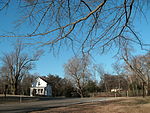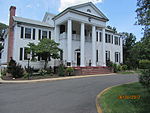Kittamaqundi
Native American history of MarylandPages with non-numeric formatnum argumentsPiscatawayPre-statehood history of MarylandSt. Mary's City, Maryland

Around 1622, the Piscataway tribe, which led the Conoy Federation, built a town they soon called Kittamaqundi on Piscataway Creek near the modern day town of Piscataway, Prince George's County, Maryland. When English first visited the town, in 1634, they learned it was named after the relatively new Tayac (Emperor) Kittamaquund, who had assumed power the previous year after killing his brother Wannas.
Excerpt from the Wikipedia article Kittamaqundi (License: CC BY-SA 3.0, Authors, Images).Kittamaqundi
Geographical coordinates (GPS) Address Nearby Places Show on map
Geographical coordinates (GPS)
| Latitude | Longitude |
|---|---|
| N 38.701786 ° | E -77.043445 ° |
Address
Accokeek
20607
Maryland, United States
Open on Google Maps











